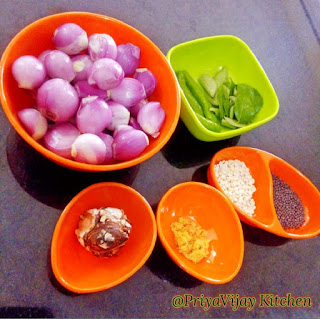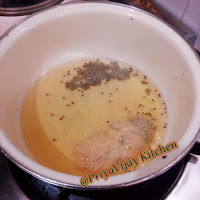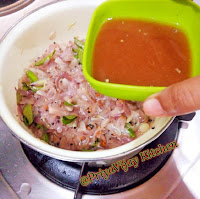Vengaya Pachadi - Onion Chilli Pachadi
Vengaya Pachadi, my favorite dish. Whenever my mom prepares , it will be mouth watering for each one in my family. No special ingredients just with basic ingredients we can prepare this pachadi. In most of the kalyana veettu sapadula (marriage function) this pachadi reserves it own place. This pachadi gives you three unique tastes (Hot, Sweet & Sour) to your taste buds.
Recipe Overview : Shallots and Green Chillies nicely sauted and cooked in tamarind pulb and finally added jaggery to give sweetness to the dish.
.............................Have a Quick look.................................
Ingredients Needed:
- Shallots – 150 g /200 g
- Green chili – 4
- Oil – 4 tbsp
- Salt as required
- Tamarind - Small lemon size
- Jaggeri (Sakkarai) – ¼ tbsp.
- For Seasoning
- Mustard seeds – 1 tsp
- Urad dal – 1 tsp
- Curry leaves – few
Preparation:
- Chop shallots vertically. [Note: Chopping vertically is important as tis gives more taste and texture to the recipe]
- Extract thick tamarind juice and keep it aside.
Method:
- In a pan add 4 tbsp of gingerly oil. Yup! 4 tbsp only! It seems it is too much but for this recipe it is must.Once oil heated up add mustard and urad dal.
- Next add vertically chopped shallots, chopped green chilies and curry leaves.
- Once shallots turns transparent, add tamarind juice and add salt also.
- Once it starts boiling, lower the flame and cook for another 10 mins .Oil will start splitting. At this stage add jiggery and saute for 2-3mins in low flame.
- Vengaya pachadi is ready!
| Author: Mano Priya Vijay |
| Ingredients Needed |
|---|
Shallots – 150 g /200 g
|
Green chili – 4
|
Oil – 4 tbsp
|
Salt as required
|
Tamarind - Small lemon size
|
Jaggeri (Sakkarai) – ¼ tbsp.
|
For
Seasoning
|
Mustard seeds – 1 tsp
|
Urad dal – 1 tsp
|
Curry leaves – few
|
Preparation:
Method:
Chop shallots vertically. [Note: Chopping
vertically is important as this gives more taste and texture to the recipe]
Extract thick tamarind juice and keep it aside.
In a pan add 4 tbsp of gingerly oil. Yup! 4 tbsp only
J It seems it
is too much but for this recipe it is must.Once oil heated up add mustard and urad dal.
Next add vertically chopped shallots, chopped
green chilies and curry leaves.

Once shallots turns transparent, add tamarind juice
and add salt also.

Once it starts boiling, lower the flame and cook
for another 10 mins .Oil will start splitting. At this stage add jaggery and
saute for 2-3 minutes in low flame.

Vengaya pachadi is ready!
Video Link :

Video Link :
Below is the you tube link for this recipe.
In Tamil there is a saying “Unavae Marunthu, Marunthae Unavu” means “Food is Medicine, Medicine is Food”. In respect to the saying, each and every food we intake in our day to day life has lots of health benefits excluding junk foods and tin packed foods, of course they contain preservatives which is unhealthy.
In Indian cuisines, we use lot of ingredients in our making of recipes, which benefits us in many ways. We use them not only for their flavor and taste but for its nutritional and medicinal value as well. If we look deeper into the traditional way of cooking, all the ingredients used in each recipes are well balanced both nutritionally and medicinally.
Each ingredients have many many health benefits but without knowing their health benefits we are using them daily. Let us know at least their important health benefits before we use and eat.
Here I have listed the health benefits of each ingredients I used in the recipe.
Ingredient 1:
Shallots – known as Chinna Vengayam in Tamil, Ulli in Malayalam, Ullipaaya in Telugu, Chikk-Eerulli in Kannada, Chotta Pyaz in Hindi. Shallots are one of the variety of onions and it belongs to the family of garlic and onions. In Indian cuisine shallots place a major role. They not only have high nutritional value, also have high medicinal value. They are used in the healing process in Ayurveda treatment. Shallots makes our body cool ie., it have cooling effect on the body hence they help in lowering inflammation, swelling etc., In simple words we can put it as shallots are Anti-inflammatory, Antioxidant, helps in lowering cholesterol, maintain blood pressure, to control diabetics.
Ingredient 2:
Green Chili – also known as Pachchii Milagai in Tamil, Patchimirapa in Telugu, Hasi Menasinakai in Kannada, Pachamulagu in Malayalam, Hari Mirch in Hindi. Green chilies are more popular in Andhra Pradesh and Telangana. Though it is very hot green chilies have many good health benefits. Green chilies are rich in Vitamin C thus it boosts immune systems, rich in antioxidants, anti-inflammatory, improves digestion, helps in skin care, weight loss.
Ingredient 3:
Salt – also known as Uppu in Tamil, Telugu, Kannada & Malayalam, Namak in Hindi. There is a saying in Tamil, “Uppu Illa sapadu kuppaiyile” meaning “Food (sapadu) without salt goes to garbage (kuppai)”. That’s show how salt is an important ingredient. Salt known as sodium chloride used as a seasoning agent in almost all recipes daily. Salt helps in digestion, improves cardiovascular health, improves hydration, helps in healthy respiratory system, vital for electrolyte balance. Salt also have negativites if taken in excess, can increase blood pressure, can lead to heart disease and stroke.
Ingredient 4:
Gingerly Oil – also known as Nallenai in Tamil, Nuvalu Nuna in Telugu, Nallenna in Malayalam, Ellenai in Kannada, Thil Ka Tel in Hindi. Gingerly oil have significant health benefits. South Indians widely use gingerly oil in their cooking. It is a good source of Vitamin D, E and B complex and antioxidants. Apart from it they are also used in cosmetic purposes, as they promotes healthy skin, reduces pimples and rashes by preventing bacterial infections, very good factor of gingerly oil is, it slows down aging of skin. We, the Tamilians have a tradition of taking oil bath (using gingerly oil) every Saturday by massaging the entire body and head. Massaging removes toxins from you and leaves you detoxified and bathing removes heat from the body. We religiously follow this tradition where new borns also have no exception.
Ingredient 5:
Tamarind – also known as Puli in Tamil and Malayalam, Chinthapandu in Telugu, Huli in Kannada, Imli in Hindi. Tamarind is a kind of fruit with have sweet and sour taste. Tamarind plays a major role in South Indian cooking, after cooking each dishes we used to ask Uppu (salt), Puli (Tamarind), Karam (Spiciness) correct ah irrukka? means if the saltness, sourness and spiciness is in correct level in the dish? That’s how puli plays major role in south indian cuisine. It improves digestion, aids weight loss, boosts immunity, rich source of vitamin C
Ingredient 6:
Jaggery – also known as Vellam in Tamil & Malayalam, Bellam in Telugu, Bella in Kannada, Gur in Hindi. Jaggery is obtained from sugarcane juice boiled at certain temperature till it solidifies. Jaggery has more health benefits compared to white sugar. White sugar just adds empty calories to your body. Nowadays people are returning back to the traditional way of using jiggery as a sweetener for the dishes they made. It is rich in fiber hence prevents constipation, improves digestion by activating digestive enzymes in our body, helps to increase hemoglobin content, it has the ability to purify the blood thus making your blood clean and healthy, I highly recommend to give Jaggery for your kids, please avoid white sugar.
Ingredient 7:
Mustard seeds – also known as Kadugu in Tamil and Malayalam, Avalu in Telugu, Rai in Hindi. Mustard seeds are most probably used by all people all over the world in some or other form either via seeds or by oil or as sauce used in their recipes. We south Indian people use it as whole seeds. They are mostly used for seasoning the dishes. It is a high nutritious seeds rich in calcium, protein, manganese, iron, zinc, omega 3 fatty acids and dietary fiber. Mustard oil helps in Hair growth, hair loss, hydrates skin, and acts as a natural scrubber.
Ingredient 8:
Urad dal – also known as Black gram in English, Ulundhu in Tamil, Uddulu in Telugu, Uddu in Kannada, Uzhunnu in Malayalam, Urad in Hindi. Like other dal varieties, urad dal is rich in fiber, helps in strengthening your back bone (South Indian culture is to give dishes made out of black gram for girl children once they attain puberty to strengthen their bones), helps in iron deficiency, reduces risk of heart disease, helps to stabilize blood sugar levels, prevent constipation.
Ingredient 9:
Curry Leaves – also known as Kariveppilai in Tamil, Karivepaku in Telugu, Karibevu in Kannada, Kariveppila in Malayalam, Kadi Patta in Hindi. Curry leaves, I should call it as a magical leaves, because it has numerous health benefits. For children this curry leaves would be annoying leaf even for me when I am kid. We the South Indians use curry leaves daily in almost every recipes we prepare, we use it while seasoning the food. When we say its health benefits, the first thing strikes our mind is that it is good for long and strong hair, apart from that there are many more. It stops diarrhea, helps in digestion, lowers cholesterol levels and blood sugar levels, good for eyesight, rich in Vitamin C thus help to clean your blood, leaving skin fresh and healthy, rich in calcium, iron. Tip: 1. Mix curry leaves powder with buttermilk for stomach upset. 2. Having curry leaves with lemon juice clears off morning sickness in pregnant women.
In Indian cuisines, we use lot of ingredients in our making of recipes, which benefits us in many ways. We use them not only for their flavor and taste but for its nutritional and medicinal value as well. If we look deeper into the traditional way of cooking, all the ingredients used in each recipes are well balanced both nutritionally and medicinally.
Each ingredients have many many health benefits but without knowing their health benefits we are using them daily. Let us know at least their important health benefits before we use and eat.
Here I have listed the health benefits of each ingredients I used in the recipe.
Ingredient 1:
Shallots – known as Chinna Vengayam in Tamil, Ulli in Malayalam, Ullipaaya in Telugu, Chikk-Eerulli in Kannada, Chotta Pyaz in Hindi. Shallots are one of the variety of onions and it belongs to the family of garlic and onions. In Indian cuisine shallots place a major role. They not only have high nutritional value, also have high medicinal value. They are used in the healing process in Ayurveda treatment. Shallots makes our body cool ie., it have cooling effect on the body hence they help in lowering inflammation, swelling etc., In simple words we can put it as shallots are Anti-inflammatory, Antioxidant, helps in lowering cholesterol, maintain blood pressure, to control diabetics.
Ingredient 2:
Green Chili – also known as Pachchii Milagai in Tamil, Patchimirapa in Telugu, Hasi Menasinakai in Kannada, Pachamulagu in Malayalam, Hari Mirch in Hindi. Green chilies are more popular in Andhra Pradesh and Telangana. Though it is very hot green chilies have many good health benefits. Green chilies are rich in Vitamin C thus it boosts immune systems, rich in antioxidants, anti-inflammatory, improves digestion, helps in skin care, weight loss.
Ingredient 3:
Salt – also known as Uppu in Tamil, Telugu, Kannada & Malayalam, Namak in Hindi. There is a saying in Tamil, “Uppu Illa sapadu kuppaiyile” meaning “Food (sapadu) without salt goes to garbage (kuppai)”. That’s show how salt is an important ingredient. Salt known as sodium chloride used as a seasoning agent in almost all recipes daily. Salt helps in digestion, improves cardiovascular health, improves hydration, helps in healthy respiratory system, vital for electrolyte balance. Salt also have negativites if taken in excess, can increase blood pressure, can lead to heart disease and stroke.
Ingredient 4:
Gingerly Oil – also known as Nallenai in Tamil, Nuvalu Nuna in Telugu, Nallenna in Malayalam, Ellenai in Kannada, Thil Ka Tel in Hindi. Gingerly oil have significant health benefits. South Indians widely use gingerly oil in their cooking. It is a good source of Vitamin D, E and B complex and antioxidants. Apart from it they are also used in cosmetic purposes, as they promotes healthy skin, reduces pimples and rashes by preventing bacterial infections, very good factor of gingerly oil is, it slows down aging of skin. We, the Tamilians have a tradition of taking oil bath (using gingerly oil) every Saturday by massaging the entire body and head. Massaging removes toxins from you and leaves you detoxified and bathing removes heat from the body. We religiously follow this tradition where new borns also have no exception.
Ingredient 5:
Tamarind – also known as Puli in Tamil and Malayalam, Chinthapandu in Telugu, Huli in Kannada, Imli in Hindi. Tamarind is a kind of fruit with have sweet and sour taste. Tamarind plays a major role in South Indian cooking, after cooking each dishes we used to ask Uppu (salt), Puli (Tamarind), Karam (Spiciness) correct ah irrukka? means if the saltness, sourness and spiciness is in correct level in the dish? That’s how puli plays major role in south indian cuisine. It improves digestion, aids weight loss, boosts immunity, rich source of vitamin C
Ingredient 6:
Jaggery – also known as Vellam in Tamil & Malayalam, Bellam in Telugu, Bella in Kannada, Gur in Hindi. Jaggery is obtained from sugarcane juice boiled at certain temperature till it solidifies. Jaggery has more health benefits compared to white sugar. White sugar just adds empty calories to your body. Nowadays people are returning back to the traditional way of using jiggery as a sweetener for the dishes they made. It is rich in fiber hence prevents constipation, improves digestion by activating digestive enzymes in our body, helps to increase hemoglobin content, it has the ability to purify the blood thus making your blood clean and healthy, I highly recommend to give Jaggery for your kids, please avoid white sugar.
Ingredient 7:
Mustard seeds – also known as Kadugu in Tamil and Malayalam, Avalu in Telugu, Rai in Hindi. Mustard seeds are most probably used by all people all over the world in some or other form either via seeds or by oil or as sauce used in their recipes. We south Indian people use it as whole seeds. They are mostly used for seasoning the dishes. It is a high nutritious seeds rich in calcium, protein, manganese, iron, zinc, omega 3 fatty acids and dietary fiber. Mustard oil helps in Hair growth, hair loss, hydrates skin, and acts as a natural scrubber.
Ingredient 8:
Urad dal – also known as Black gram in English, Ulundhu in Tamil, Uddulu in Telugu, Uddu in Kannada, Uzhunnu in Malayalam, Urad in Hindi. Like other dal varieties, urad dal is rich in fiber, helps in strengthening your back bone (South Indian culture is to give dishes made out of black gram for girl children once they attain puberty to strengthen their bones), helps in iron deficiency, reduces risk of heart disease, helps to stabilize blood sugar levels, prevent constipation.
Ingredient 9:
Curry Leaves – also known as Kariveppilai in Tamil, Karivepaku in Telugu, Karibevu in Kannada, Kariveppila in Malayalam, Kadi Patta in Hindi. Curry leaves, I should call it as a magical leaves, because it has numerous health benefits. For children this curry leaves would be annoying leaf even for me when I am kid. We the South Indians use curry leaves daily in almost every recipes we prepare, we use it while seasoning the food. When we say its health benefits, the first thing strikes our mind is that it is good for long and strong hair, apart from that there are many more. It stops diarrhea, helps in digestion, lowers cholesterol levels and blood sugar levels, good for eyesight, rich in Vitamin C thus help to clean your blood, leaving skin fresh and healthy, rich in calcium, iron. Tip: 1. Mix curry leaves powder with buttermilk for stomach upset. 2. Having curry leaves with lemon juice clears off morning sickness in pregnant women.






No comments:
Post a Comment